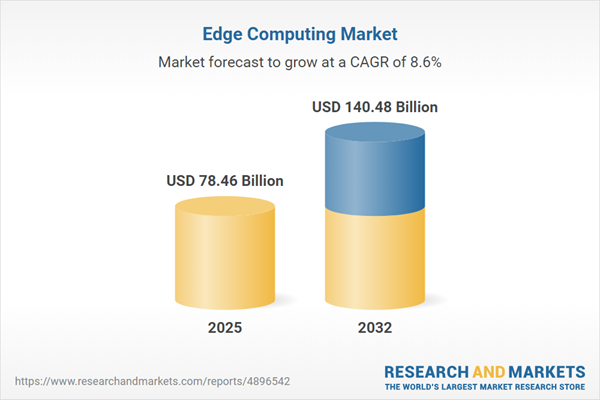Speak directly to the analyst to clarify any post sales queries you may have.
Edge computing is transforming enterprise digital strategies by enabling near-instant data processing, reduced latency, and new pathways for intelligent decision-making at the network edge. As businesses seek to keep pace with rapid digital transformation and demanding workloads, the edge computing market is experiencing a robust expansion in both adoption and innovation.
Market Snapshot: Edge Computing Market Size & Growth Trajectory
The Edge Computing Market grew from USD 72.54 billion in 2024 to USD 78.46 billion in 2025. Continuing on its upward curve, it is expected to expand at a CAGR of 8.61%, ultimately reaching USD 140.48 billion by 2032. This growth is driven by widespread industry adoption, the proliferation of connected devices, and advancements in network infrastructure, notably the integration of AI at the network edge.
Scope & Segmentation: Comprehensive Edge Computing Analysis
This report delivers in-depth analysis across segments, underlying technologies, geographical nuances, and leading provider strategies. Market segmentation and coverage include:
- Component: Hardware (Microprocessors, Networking Equipment, Sensors), Services (Managed Services, Professional Services), Software
- Network Connectivity: 5G Networks, Wi-Fi Networks, Wired Networks
- Deployment Mode: Cloud, On-Premise
- Application: Content Delivery & Optimization, Data Analytics, IoT (Consumer IoT, Industrial IoT), Security & Monitoring
- End-User: Automotive, Business & Finance, Energy & Utilities, Government & Defense, Healthcare & Life Sciences, Manufacturing, Retail & E-Commerce, Telecommunication & IT, Transportation & Logistics
- Organization Size: Large Enterprises, Small & Medium Enterprises
- Regional Coverage: Americas (North America: United States, Canada, Mexico; Latin America: Brazil, Argentina, Chile, Colombia, Peru), EMEA (Europe: United Kingdom, Germany, France, Russia, Italy, Spain, Netherlands, Sweden, Poland, Switzerland; Middle East: United Arab Emirates, Saudi Arabia, Qatar, Turkey, Israel; Africa: South Africa, Nigeria, Egypt, Kenya), Asia-Pacific (China, India, Japan, Australia, South Korea, Indonesia, Thailand, Malaysia, Singapore, Taiwan)
- Key Companies Analyzed: Major industry providers, including Amazon Web Services, Microsoft Corporation, Cisco Systems, Google LLC by Alphabet Inc., Intel Corporation, Dell Technologies Inc., along with regional innovators and semiconductor specialists
Key Takeaways: Strategic Insights into the Edge Computing Market
- Edge computing empowers organizations to process critical data locally, improving operational efficiency and supporting real-time, data-driven applications across diverse sectors.
- Accelerated adoption of 5G technology and AI integration at the edge is fueling new industry use cases, ranging from autonomous manufacturing to smart city infrastructure.
- The market ecosystem includes robust hardware innovation, growing service models, and security-driven software solutions, ensuring adaptability to varying industry demands.
- Regional deployment strategies are shaped by varying regulatory environments, investment climates, and sector-specific needs—requiring tailored go-to-market approaches.
- Strategic alliances, targeted acquisitions, and technology partnerships play a critical role in shaping the competitive landscape and driving transformative outcomes.
- Large organizations lead in adoption, while flexible, scalable solutions empower small and midsize enterprises to explore new opportunities and validate edge use cases cost-effectively.
Tariff Impact: Navigating Evolving Trade Policies
U.S. tariff measures planned for 2025 will introduce higher duties on critical hardware such as gateways, routers, and servers, with potential knock-on effects for software licensing and support costs. Industry players are pursuing alternative manufacturing locations, regional partnerships, and diversified supply chains to minimize cost impacts. Organizations adapting early through adjusted sourcing and revised contractual arrangements can mitigate expense increases and create resilience in the value delivery chain.
Methodology & Data Sources
This edge computing report employs a multiphase research framework combining primary engagements with executives and technical experts, systematic secondary analysis of whitepapers and filings, and rigorous expert validation to ensure reliable, actionable insights.
Why This Report Matters
- Provides strategic, actionable intelligence for decision-makers navigating evolving edge computing trends, business models, and technology adoption challenges.
- Delivers a segmented, regionally attuned perspective to support investment planning, competitive positioning, and risk mitigation for senior leaders.
Conclusion
As edge computing becomes integral to digital transformation strategies, organizations leveraging tailored insights, resilient supply chains, and innovative technology partnerships will strengthen their operational agility and secure long-term growth in an evolving digital landscape.
Additional Product Information:
- Purchase of this report includes 1 year online access with quarterly updates.
- This report can be updated on request. Please contact our Customer Experience team using the Ask a Question widget on our website.
Table of Contents
3. Executive Summary
4. Market Overview
7. Cumulative Impact of Artificial Intelligence 2025
Companies Mentioned
The companies profiled in this Edge Computing market report include:- Amazon Web Services, Inc.
- Microsoft Corporation
- Accenture PLC
- Advanced Micro Devices, Inc.
- Arm Holdings plc
- C3.ai, Inc.
- Capgemini SE
- Cisco Systems, Inc.
- Cognizant Technology Solutions Corporation
- Dell Technologies Inc.
- Fujitsu Limited
- Google LLC by Alphabet Inc.
- Hewlett Packard Enterprise Company
- Huawei Technologies Co., Ltd.
- Infosys Limited
- Intel Corporation
- International Business Machines Corporation
- MediaTek Inc.
- NIPPON TELEGRAPH AND TELEPHONE CORPORATION
- NVIDIA Corporation
- NXP Semiconductors N.V.
- Oracle Corporation
- Palantir Technologies Inc.
- Panasonic Holdings Corporation
- QUALCOMM Incorporated
- Robert Bosch GmbH
- Samsung Electronics Co., Ltd.
- SAP SE
- Siemens AG
- Tata Consultancy Services Limited
- Texas Instruments Incorporated
- Wipro Limited
Table Information
| Report Attribute | Details |
|---|---|
| No. of Pages | 197 |
| Published | November 2025 |
| Forecast Period | 2025 - 2032 |
| Estimated Market Value ( USD | $ 78.46 Billion |
| Forecasted Market Value ( USD | $ 140.48 Billion |
| Compound Annual Growth Rate | 8.6% |
| Regions Covered | Global |
| No. of Companies Mentioned | 33 |









